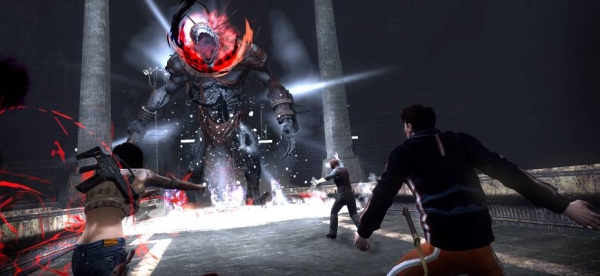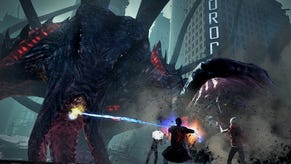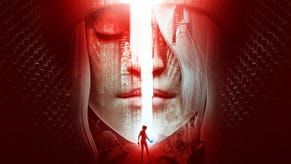Interview: The Secret World Drops Subscription
Revealing
The Secret World has dropped its subscription and purchasing the client will now provide access to all existing content, with no ongoing fees. Ahead of the announcement, I spoke to game director Joel Bylos and Funcom's director of communications Erling Ellingsen to find out what this means for the future and why the decision has been made now. In a frank interview, we discussed whether players can still expect regular updates and how the team hope to make the new model profitable. We also talk about the shadow cast by Guild Wars 2 and Blizzard, and the future of subscription-based MMOs.
RPS: Hello. So, The Secret World no longer has a subscription cost. Let's talk about that! Presumably, this means you’ll be looking for ways other than a monthly fee to earn money through the game?
Bylos: What we’re doing is we’re still having the client price.
Ellingsen: It’s important to point out that we’re not going free to play. It’s buy to play.
Bylos: Yes, it’s buy to play. More like Guild Wars 2. There’s still an optional membership though, but the way that we’ve targeted it, that we think is best for the game, is that the $30 client gives the full experience. Buying a membership gives additions, such as in-game cash for outfits and things like that and a discount in the store. You do get an item that’s subscriber-only as well. A cosmetic item that’s only for subscribers – or members. Members is the right phrase now!
RPS: Terminology!
Bylos: The hardest thing is changing all the terminology.
Ellingsen: It’s not an MMO anymore! Just kidding. (laughs)
Bylos: The idea is that lifetime members and people who go for a membership now will get extra in-game cash, discounts in-store, a cosmetic item every month that boosts their XP, usable once a day. The way we’re aligning that is that we don’t have rested XP like WOW, so this is like our rested XP for people who take a membership. We’re trying to give an advantage for being a member rather than taking away from non-members.
RPS: Is the in-game store going to be more important now, from a business perspective? To add more content and increase its attractiveness?
Bylos: Without a doubt. We have to increase the average revenue per user in the store. The first function of doing that is having more people in the game. You can’t achieve more store sales without having a higher population. The store does become more important. The client fee is important as well but we’ll probably do more regular updates to the store and put more focus on that.
RPS: There was an interview a couple of months ago in which you and Ragnar spoke, and you said that GW2 had been, if not necessarily a shock, a game-changer.
Bylos: Yeah. We tried with the subscription model and we knew the momentum was against us, especially in the gamer mindset. People have become more and more fed up with subscriptions.
RPS: Do you think there’s a future for them at all? I get the impression that you guys really believed in the benefits of the system, particularly in regards to regular updates.
Bylos: Oh, we do. We tried to be a responsible subscription company and release something every month to give value for that money. Ignoring that I work here, I felt that as a gamer, that is what I’d want to see from a subscription game.
But it really hasn’t paid off in the end, so we have to make some changes to bring more people in. But in terms of the subscription dying, I think Blizzard are laughing at us all from atop their thrones. Whenever I hear people say that subs are dead, I point to the biggest money-makers in the industry.
RPS: But would you agree that it’s becoming more and more difficult for a smaller company or newcomer to attract subscribers?
Bylos: Absolutely, yes. What I think we’re seeing is that the margins are being pushed so you have to be a big company to create this huge, AAA quality game that people want to pay a subscription for forever. Blizzard have a lot of momentum and social factors as well. They are the Facebook of games with WOW.
I don’t want to take that away from them but if they release Titan and offer a subscription, I don’t think they’ll have any trouble getting people to pay out for that. But people who aren’t as large, like Funcom, we tend to live vicariously from game to game. Profits from one game have to fund the next one. I don’t think Blizzard have had that problem for the last ten years or so. I think that companies like us really need to evaluate where we’re going to land and I don’t think subscriptions are the way ahead.
All of this will tend to push things in different ways. You’ll have your Kickstarter, crowd-funded very niche MMOs and then the big, NCSoft-backed GW type MMOs. NCSoft are the largest MMO publisher in the world. And then there’s Blizzard and companies like that, and then in the middle tier there’s companies like us, and we’re being pushed to one side or the other.
RPS: In some ways, TSW is a niche game in its field. The emphasis on story and written characters, even the modern setting. It doesn’t necessarily marginalise its appeal but there’s a buy-in that people have to accept, and with all that, it feels like quite a high budget game. It seems to me that there’s probably a lot of expense in terms of bringing in actors, getting mo-cap done, for new content.
Bylos: I think we do it on the cheap! (laughs) I know that Bioware had something like forty animators working on Mass Effect 3 for all their custscenes. We had two guys and they’re fantastic at their job. I can’t speak highly enough of them. To deliver three of those motion-captured scenes a week, which is the rate they were delivering at just before launch, is incredible.
I think, absolutely, we have a very strong veteran team in terms of doing stuff like that so it doesn’t cost us as much as it might seem from the outside. But it does take us longer to produce content, probably because it’s high quality and the bar has been set to a point where if it becomes lower quality people will notice immediately.
RPS: One of the things I thought from the beginning is that to continue the stories, you’d committed to a fully-voiced world and if you step away it’s immediately noticeable. There’s an aesthetic, a standard, and is there now a danger that you have to lower that bar, or even to move away from monthly updates and to follow a more traditional expansion pack route?
Bylos: While I’m game director I don’t want the bar to drop at all. As lead content designer I was responsible for setting that quality level in all cases, so I don’t expect the quality to change.
As for updates, I don’t really want to say monthly, because then people want to hold us to a 30 day plan, but the aim is to carry on with regular updates.
RPS: Not to switch to larger expansions then? One of you guys recently compared TSW’s subscriptions as being like a HBO subscription – customers expect updates for the money that they’re spending, but if people are buying in and then not spending every month, they could well be happier to wait six or even twelve months for a big content drop.
Bylos: That’s not for us. I encourage people to think more about the game like Borderlands 2 now. You buy the game and then there are packs, but free updates as well. Like, we sell the issues – we’ll be about to release issue five when this goes out and that will continue – six, seven, eight, nine, ten and so on. Within those issues there will be some free content and some DLC, paid content.
As you mentioned, one of our greatest selling points is story, so we might bundle up a mission pack and sell that to people through the store. But there will still be some missions added, PvP updates and raids and things like, which are completely free. That’s the area where we’re aiming to expand, continuing to give people pieces of the story.
The difference now, and this might sound a little tongue in cheek, is that with a subscription model, in six months you come back and pay fifteen dollars and get everything. With this model, you’ll have to buy episode by episode to get everything you might want. That’s a difference I would draw, but the analogy of having a series is still the same.
RPS: Beyond the good feedback, including from a very important man, there have obviously been a lot of difficulties. The team is a lot smaller now and financially the game isn’t where you want it to be, but it’s clear that you still believe in it. This feels like a big change. How difficult is it to find ways to make this work? In the past, the subscription model was always described as a driving force behind regular, quality content.
Bylos: We’ll see how this pays off! I really can’t tell you. We have to see if people are still willing to get into the game. Personally, we believe in the game. Nothing has changed there. We’re excited about the stuff we’re delivering every month. We’re excited about the missions in issue five.
One of the things that me and Ragnar discussed and that’s happening now relates to the fact that we recorded a lot of dialogue and cinematics before release that haven’t been used yet. So we’ve been ‘shotgun firing’ those into the game. As they run out, we’re moving into a stronger, tighter story focus in the missions.
In issue five you’ll see the first example of that. “The Vanishing of Tyler Freeborn” is a story about a conspiracy nut who lives on Solomon Island it’s about investigating his disappearance. It’s a chain of missions that we expect to take two or three hours to play through and it fills in plenty of backstory. That’s the direction these DLCs will go as well, telling self-contained stories. The one for issue six is about getting five hours of gameplay into a story people will be interested in.
That will work out well for us. In terms of the voice actors and animators, we can concentrate our efforts, and also create a much more coherent experience for people.
RPS: I stupidly said, when issue 2 came out, that it was amazing how you were able to get all the required voice actors back together, but obviously they were recordings kept back from earlier sessions. Now that you’re moving on to new recordings, does that give you more chance to take into account the characters and stories that people are most interested in?
Bylos: I tend to read all of the community feedback, obviously not all of it is useful – that’s the internet – but we run loads of polls about favourite characters and stuff like that. We make note of those characters and we tend to like them ourselves as well. We do have lists of characters that people love and that nobody seems to like.
Then we ask, is there more of that story to be told? If people continue to give us feedback we’ll continue to listen, but when you’re directly selling story packs, people will vote with their wallets. If a story is amazing, we’ll see the results in terms of sales. From a design perspective, I enjoy that we get to make small experiences that are very focused for every piece of DLC. That’s fun to contemplate. In Egypt there are going to be some very cool setpieces happening.
RPS: Does it feel like you have more flexibility then, now that you’re moving away from that immediate post-launch phase when so much content was pre-built? I know there are set points to reach, the end of specific acts and the opening of new areas like Tokyo, but do you have a bit of flexibility now as a writer and designer?
Bylos: Yeah. There has been a lot of stuff that was lingering and that we wanted to get in. For example, the raid was something that we’d started on before launch but took a long time to get in post-launch because it’s a very complex thing. We have other raids planned, and things like that, that we can now work on.
We do have more flexibility in terms of the story direction mechanics. You lock down mechanics for launch but then can experiment and add new stuff. We’re adding interactions in the world with the auxiliary weapons – imagine points in the world where rocket jumping is available to get across gaps. These are things that weren’t planned a long time ago but that we enjoy the idea of.
RPS: And in terms of adding an entirely new zone, Tokyo, do you have a date for that? Realise that I’m asking this knowing that release dates are nonsense and that you just said you don’t want to be tied down to 30-day promises and the like. (laughs)
Bylos: We’ve always said early 2013. We’ll be there in the first half of 2013. It’s in production and I don’t know exactly when it will be done at the moment.
RPS: That content adds a completely new location and playfield. With the smaller team, is there a risk that building more new locations is out of your scope and that it’ll be story packs from here on in?
Bylos: No. It’s a matter of adjusting team expectations. We don’t need to deliver 1500 by 1500 playfields every time. They can be 500 by 500. As long as I’ve been a designer, it’s been a matter of adjusting to the box that you have.
With that said, with the team we have we are still very strong. The development pace is strong. The guys are delivering a lot of stuff and even though losing a lot of people slowed us down a bit, we didn’t lose 50% of the team and 50% of production. It was more like 50% and 20%. That’s people getting better at the tools and the job, and adjusting to the situation.
Ellingsen: It’s also important to point out that making this change doesn’t mean we have less resources – hopefully it means we have more. But of course it all depends on how this goes. But we have our business cases and we hope that this makes us grow and provides more resources.
Bylos: I think subscription puts that psychological barrier in peoples’ minds. I think GW2 got the best of both worlds in that regard. They removed the psychological barrier of subscription but also have the client price that keeps out undesirables. We think that’s a very good idea and there’s no bones about that.
Check back later this week for the remainder of the conversation, in which we discuss the challenges ahead and future content in more depth. And then Joel asks RPS some questions of his own.





















